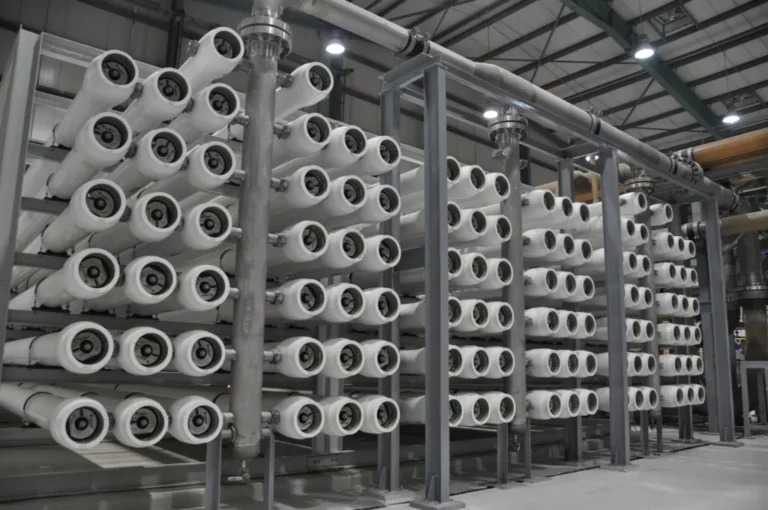Introduction
No 1 Best Silica Control in RO Systems. Silica (SiO₂) is one of the most stubborn and costly foulants in reverse osmosis (RO) systems. Unlike calcium or sulfate salts, silica deposits are hard, glassy, and difficult to remove, often requiring chemical cleaning or even membrane replacement. Effective silica control is therefore critical for consistent RO performance and long membrane life
Silica Control in RO Systems
No 1 Best Silica Control in RO Systems. Silica (SiO₂) is one of the most stubborn and costly foulants in reverse osmosis (RO) systems. Unlike calcium or sulfate salts, silica deposits are hard, glassy, and extremely difficult to remove, often requiring aggressive chemical cleaning or even membrane replacement. Because silica forms both reactive and colloidal forms, it poses a unique challenge for industries operating high-recovery RO plants. Effective silica control is therefore critical for consistent RO performance, stable operation, and long membrane life. Read more
Silica Causes Problems
- Sharp increase in differential pressure
- Reduced permeate flow
- Difficult membrane cleaning
- Irreversible loss of productivity
Factors Affecting Silica Scaling
Parameter Effect on Silica Solubility
pH Solubility increases above pH 8.5, decreases below pH 7
Temperature Higher temperature lowers silica solubility
Presence of other ions Metal ions (Al³⁺, Fe³⁺, Mg²⁺) promote polymerization and precipitation
Recovery rate Higher recovery increases silica concentration and scaling risk
Case Example: High Silica Groundwater RO Plant
No 1 Best Silica Control in RO Systems. A textile industry operating with groundwater containing 55–70 ppm silica faced rapid membrane fouling every 3–4 months. After switching to a high-performance silica inhibitor and adjusting recovery from 75 percent to 70 percent:
• Membrane life increased from 9 months to 30 months
• Cleaning frequency reduced by more than 60 percent
• Permeate output improved by 12 percent
• Operating cost reduced significantly
This example shows how small adjustments combined with the right chemical solution create major improvements.
Silica Control Methods
1. Feedwater Pretreatment
Clarification or filtration to remove colloidal silica.
Coagulation using aluminium or iron salts to remove fine particles.
2. Operating Optimization
Limit RO recovery to keep concentrate silica < 120 ppm (typical limit for most membranes).
Maintain pH between 7.0–8.0 for best silica stability.
Monitor SDI and turbidity regularly.
3. Use of Silica Control Antiscalants
Modern RO antiscalants, like Memco RO Silica Inhibitors, are specially designed to:
Delay polymerization of reactive silica.
Disperse colloidal silica particles, preventing agglomeration.
Stabilize silica up to 250–300 ppm in concentrate stream (depending on conditions).
Work synergistically with phosphonates and dispersants to control both silica and carbonate
scales.
Silica Scale Removal
No 1 Best Silica Control in RO Systems. If silica has already deposited, cleaning is challenging. High-pH cleaners (pH > 11) with special chelants or surfactants may help partially dissolve silica scale. However, prevention is far more effective than cleaning.
Types of Silica Found in RO Feedwater
Understanding the form of silica present in water is essential for choosing the correct treatment method.
Reactive Silica
This is the dissolved form (monomeric silica). It contributes most to scaling because it polymerizes and forms hard deposits when concentration increases.
Colloidal Silica
These are fine, suspended particles that cannot be removed through softeners or traditional pretreatment. Colloidal silica causes high SDI and turbidity and blocks membrane surfaces.
Particulate Silica
Larger particles usually removed by multimedia filtration, UF, or coagulation. If not removed, they settle on the membrane surface and increase fouling.
Different RO systems require different dosing strategies depending on which type is dominant.
Why Choose Memco Silica Control Antiscalant
- Proven formulation effective up to 300 ppm SiO₂
- Non-acidic, safe for all RO membranes
- Provides simultaneous protection against CaCO₃, CaSO₄, and Fe fouling
- Compatible with online dosing systems
- Supported by Memco technical team for feedwater analysis and dosing recommendations
Conclusion
Silica control is one of the most critical aspects of successful RO operation. By combining proper pretreatment, optimized recovery, and Memco silica inhibitor, operators can:
- Increase recovery safely
- Reduce membrane cleaning frequency
- Extend membrane lifespan
- Maintain consistent permeate quality
Contact Us
If you are looking for the Silica Control in RO Systems: Challenges and Solutions, get in touch with us today.
Call: +91 96773 31937
Email: vchemcare@gmail.com

